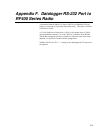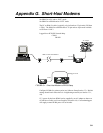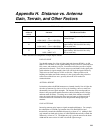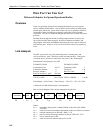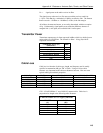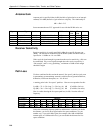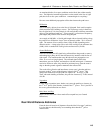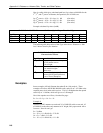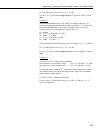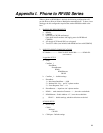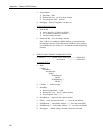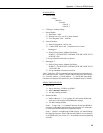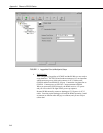
Appendix H. Distance vs. Antenna Gain, Terrain, and Other Factors
H-5
As mentioned before, free space conditions are the ideal, but seldom actually
seen. The higher the antenna height relative to the terrain in the line of sight
path, the closer to free space conditions. Antenna height is everything!
Here are some additional propagation effects that increase the path losses:
Diffraction
This is caused by objects close to the line of sight path. Real world examples
of this would be hills, buildings, or trees. The object may not be in the direct
line-of-sight, but if it is close enough, it will cause the RF to diffract around the
object, giving additional path loss. “Close enough” is a function of frequency,
path length, and position of the obstacle along the path.
An example at 900 MHz: a 10 mile path length with an obstacle halfway along
the path will see diffraction “losses” from an obstacle within ~70 ft. of line-of
sight. The amount of loss would be from 6 dB to 20 dB, depending on the
obstacle surface. A sharp edge (like a rock cliff) would give the minimum loss
(6 dB), while a rounded hill would give the maximum loss (20 dB).
Ground Reflections
These are caused by the RF signal being reflected from the ground (or water),
and undergoing a phase shift so that it destructively interferes with the line of
sight signal. The conditions that cause this the most are propagation over
water, or over a low-lying fogbank. The reflected signal suffers little
attenuation, gets out of phase, and interferes with the main signal. If antennas
need to be sited near water, they should be positioned away from the water’s
edge so that the ground vegetation attenuates the reflected RF.
The result of the reflection and interference (worst case) is that the path loss
increases as the 4
th
power of the distance, instead of the 2
nd
power. This
changes the distance term in the path loss equation to: 40 x log ( d ) dB.
Then, with each doubling of distance, the path loss increases by 12 dB, instead
of 6 dB.
Vegetation
Losses due to vegetation (trees, bushes, etc) cause the path loss to increase by
the 3
rd
to 4
th
power of the distance, instead of the 2
nd
power. This is just like in
the severe ground reflection case above.
Rain, Snow, and Fog
Below 10 GHz, these don’t have much effect on path loss (see Ground
Reflections).
Real World Distance Estimates
From the above discussion of departures from the ideal “free space” path loss,
it is clear that we should usually use something other than the 2
nd
power
distance table.



